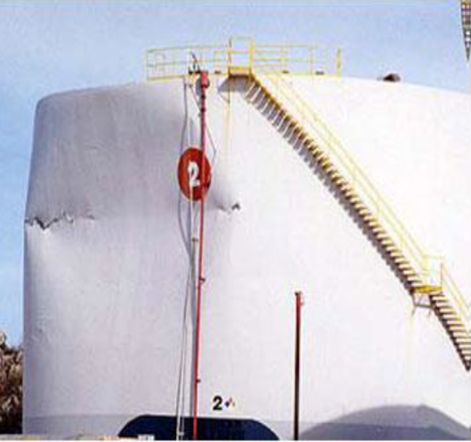
It is our everyday knowledge that special care is needed to move any small container partially filled with liquid.
Experience teaches us that the unrestrained free surface of the liquid tends to undergo rather large movement even when the container has small motions, and one has to carefully adjust the frequency of the container motion to avoid excessive movement of the liquid.
Take your cup of coffee for example. It's the morning, you're tired and need some caffeine to get you going. You fill it to the top and start to walk. Knowing the coffee is moving as you walk, you take some sips and carefully balance the cup in to avoid any spillover. The same principle of liquid movement within a confined space applies to our industry with designing pressure vessel and tanks. Here's why it matters for your design.

What Is Sloshing & Why Does it Matter?
Sloshing refers to the oscillation of free liquid surface inside a partially filled container. It can be caused by any excitation to the container. The motion types of the free liquid surface depend on the excitation type and the shape of the container. It can be simple planar, nonplanar, rotational, irregular beating, symmetric, asymmetric, quasi-periodic, and chaotic [1]. Liquid sloshing can be of great concern in many applications in mechanical, civil, aerospace, and marine engineering since it can excite the natural frequency of the system and lead to structural instability or failure.
For instance, the propellant sloshing prevented SpaceX Flacon 1 from reaching full orbit [2]. There have also been reports that sloshing liquid can damage the roof and the top of storage tanks during earthquakes as shown in the figure above [3].
To further prevent these damages, more engineers are addressing sloshing in their design.
What Does the Code Say?
Under ASME Section VIII, Division 1, consideration of loadings due to seismic events is required.
Therefore, pressure vessel engineers and designers now have to consider the liquid inside of the vessel as well as the load associated with sloshing. For cylindrical tanks, additional procedures for evaluating sloshing loads are covered in standards and guidelines like API 650, Appendix E, and Eurocode 8.

when to Consider sloshing in Your Design
Sloshing, and its effects on vessels and tanks, isn't anything new in our industry. In fact, it's become crucial for engineers and designers to adopt into their design as it's now required by code. At Paulin Research Group, we understand this need and provide our users with helpful tools to anticipate and visualize the effects sloshing may have on a design.
Our design and analysis products, like Konnect, can automatically calculate these seismic loads and further anticipate the impact of liquid sloshing within a container. On the vessel side, Vessel Link can evaluate these loads and validate the design against ASME Section VIII, Div 1 code.
To learn more, set up a complimentary consultation with one of our design experts today.
References
[1] R. A. Ibrahim, "Liquid Sloshing Dynamics," Cambridge University Press, New York, 2005.
[2] N.A. "Declares Falcon 1 Operational despite Problem on Demo Flight.” SpaceNews, spacenews.com/spacex-declares-falcon-1-operational-despite-problem-demo-flight/, 19 Jan. 2023.
[3] P. K. Malhotra, T. Wenk, M. Wieland, "Simple procedure for seismic analysis of liquid-storage tanks," Structural Engineering International, 10(3) (2018) 197-201.
[4] A. I. Celik, T. Akgul, "Stress analysis of cylindrical steel storage liquid tanks during the instantaneous loads," Proceedings of the 3rd World Congress on Civil, Structural, and Environmental Engineering (CSEE18), Budapest, Hungary, April 8-10, 2018.


